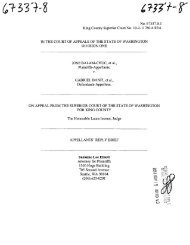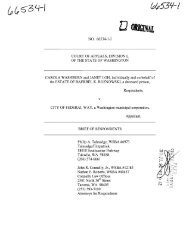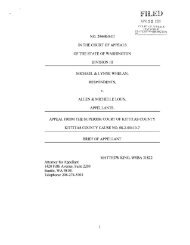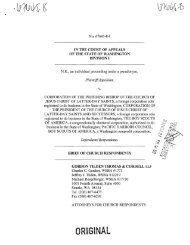Appellant's Brief - Washington State Courts
Appellant's Brief - Washington State Courts
Appellant's Brief - Washington State Courts
You also want an ePaper? Increase the reach of your titles
YUMPU automatically turns print PDFs into web optimized ePapers that Google loves.
Specific criminal intent may be inferred from the defendant's<br />
conduct where it is "plainly indicated as a matter of logical probability."<br />
<strong>State</strong> v. Delmarter, 94 Wn.2d 634, 638, 619 P.2d 99 (1980). Here, the<br />
only conduct of Mr. Hendrickson of which there was evidence was the fact<br />
that he placed a box by the rear of the trailer then walked into the auto<br />
body shop. Mr. Hendrickson's intent to use the information found in the<br />
trailer in a criminal manner is not "plainly indicated as a matter of logical<br />
probability" from his act of dropping a box off at the end of the trailer.<br />
Viewing all the evidence in a light most favorable to the <strong>State</strong><br />
establishes only that Mr. Hendrickson possessed the information, but not<br />
what he intended to do with it. The <strong>State</strong> presented insufficient evidence<br />
to establish beyond a reasonable doubt the intent element of any of the<br />
charges of identity theR.<br />
When reviewing a trial court's denial of a Knapstad motion, an<br />
appellate court conducts the same inquiry as when it reviews the sufficiency<br />
of the evidence to sustain a conviction. Sdafe v. Israel, 1 13 Wn.App. 243,<br />
269 n. 6, 54 P.3d 1218 (2002), review denied, 149 Wn.2d 1013, 69 P.3d<br />
874 (2003). For the reasons stated above, the trial court erred in denying<br />
Mr. Hendrickson's Knapstad motion.

















